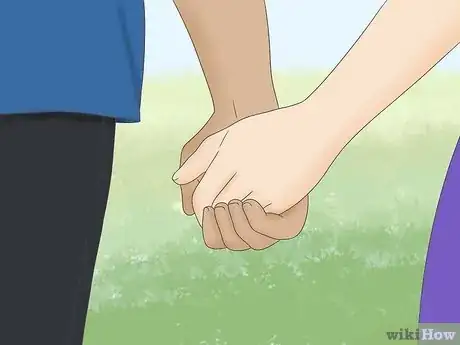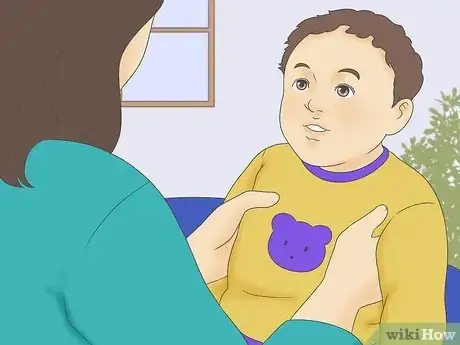This article was co-authored by Leslie Bosch, PhD. Dr. Leslie Bosch is a Developmental Psychologist, National Board Certified Health and Wellness Coach, and Owner of Bosch Integrative Wellness. With over 15 years of experience, she specializes in providing stress relief coaching services to individuals and groups using a variety of scientifically proven methods for change including motivational interviewing, positive psychology, self-compassion, non-violent communication, social learning theory, and self-determination theory. Dr. Bosch received training from the Andrew Weil Center for Integrative Medicine at the University of Arizona and earned a PhD in Human Development and Family Studies from The University of Arizona. She is also a member of the National Board of Health and Wellness Coaching Association. Dr. Bosch has published many papers and been featured in the media numerous times.
There are 8 references cited in this article, which can be found at the bottom of the page.
This article has been viewed 22,249 times.
Your attachment style plays a major role in how you function in relationships. It also says a lot about how you feel about yourself. Your attachment style may help you thrive when getting close to others, or it may make your relationships suffer. You can figure out what your style is by sizing yourself up again common attachment styles, assessing your personality, and taking a look at your childhood.
Steps
Comparing Yourself to Common Attachment Styles
-
1Define attachment. Attachment is the ability of one being to form emotional bonds with another. When attachment is in its healthiest state, you can build stable and enjoyable relationships with friends and family. However, if for some reason you have developed an insecure attachment as a result of traumatic experiences, then attachment issues may develop and make it difficult to form and keep stable relationships.
- Your attachment style is developed and molded repeatedly from many experiences and events that you are exposed to early on in your life.
- How a caregiver responded and nurtured you as a child can affect your attachment style.
- Any trauma you may have witnessed or experienced can also play a role.
- You may also have a predisposed biological, cognitive, or psychological condition that affects your attachment style.
- You can continue to work on your attachment style throughout your life.
- Even if you had an avoidant attachment style in childhood, you might acquire a secure style with your spouse, friend, or other people over time.
-
2Secure attachment. The ability to have a stable and healthy relationship. The capacity to see others in a relationship with little to no distortions. The person with a healthy and secure attachment style is able to value the relationships he is in, and able to verbally and behaviorally express their affections. They can freely love and receive love from others.Advertisement
-
3Dismissive attachment. This person may appear to be standoffish, and gets uncomfortable when others attempt to show affection or a deeper connection in the relationship. A person with this type of attachment style can seem to be dismissive of the emotional and physical needs of the other person(s) in the relationship. This individual will also have difficulty voicing his needs and desires to others as well.
- Other personality traits that may be associated with dismissive attachment are passive-aggressive and sarcastic behaviors.
- They may have a fear of being dependent on the other person because they perceive this as weak.
-
4Preoccupied attachment. Someone with this type of attachment style is overly preoccupied with relationships and attachment. These people will typically relive and tell their stories over and over again of their past poor relationship experiences. They may constantly review their internal dialogue and relive all of their past pain and rejections signifying a lack of resolution.
- Other personality traits that may be associated with this attachment style are controlling behavior and difficulty conforming to rules, being argumentative, and impatience.
- Some people may be manipulative and plan out actions to get what they want out of the relationship.
- They also can exhibit a strong sense of creativity and charming qualities.
-
5Disorganized attachment. These individuals will often exhibit disorganized thoughts and relationship patterns. People with disorganized attachment style may have other underlying diagnoses, such as Borderline Personality Disorder. These people may have had a traumatizing childhood of abuse, neglect, or frequent experiences of loss. Caregivers during their childhood may have been emotionally unavailable, unresponsive, or inconsistent. They learned not to fully trust others, and develop insecurities with getting close to another person because they see themselves as unlovable and not good enough for healthy support.
- Other behavioral characteristics associated with a disorganized attachment style include a lack of empathy and remorse, selfishness, and a disregard for rules.
- These individuals are at a higher risk of substance abuse or dependence, abusing others, and criminal behavior.
-
6Assess your level of security in yourself and your relationships. People with secure attachment styles have high self-esteem and are comfortable receiving and giving love. They don’t look towards others to find value with themselves and feel comfortable with intimacy, but aren’t co-dependent. They also stay calm in arguments and are mentally flexible.
- People with secure attachments often had stable and loving upbringings. They had their needs met and lived in a nurturing environment.[1]
-
7Check for clingy behaviors. Ask yourself if you are clingy in relationships and constantly worry about what others think of you. If you look to others to complete you, want your partner to rescue you, and are in fear of rejection and abandonment, you likely have an anxious attachment type. People with this attachment style crave intimacy and become obsessed with the details of their relationship. They worry that the slightest changes in a relationship mean that it is going to end.
- Those with anxious attachment styles grew up unsure of what kind of treatment they would receive from their parents.
- Sometimes they were met with love and care, while other times they would experience insensitivity and abandonment.
- As a result, they are constantly seeking the approval of others.[2]
-
8Decide if you shy away from intimacy. Those with avoidant attachment styles try to detach themselves from relationships. They are often emotionally distant and tend to withdraw from others. They are able to turn off their feelings and become non-reactive, even during an argument.
- People with avoidant attachment styles are often raised by parents who are insensitive to their children’s needs.
- They themselves are emotionally withdrawn and typically discourage their children from crying or showing emotion.
- They want their children to become independent as soon as possible and have little reaction when their child is upset or in need of nurturing.
Assessing Your Personality
-
1Take a look at your self-esteem. It’s no secret that the way parents treat their children affects their self-esteem for the rest of their lives. How you feel about yourself is a good indicator of what attachment style you have. Be honest when evaluating yourself and you’ll get the most reliable answer.
- Are you happy with yourself or do you have feelings of self-hatred?
- Do you value yourself or do you think you are worthless?
- You likely have a healthy attachment style if you have high self-esteem.
- Those with low self-esteem typically have unhealthy attachment styles.[3]
-
2Ask yourself how you respond in arguments. How you engage in an argument says a lot about your attachment style. It reveals how you handle conflict and probably reflects the way you saw your parents behave in arguments, as well.
- Do you stay calm in arguments or do you walk away and try to avoid the situation altogether?
- Do you scream, lash out, name call, and vow to “get even” during a fight?
- The answer to these questions can reveal your attachment style.[4]
-
3Think about your romantic relationships. Your behavior in a romantic relationship is perhaps the biggest clue when determining your attachment style. The way in which you respond to your partner and how attached you become to them says a lot. Being honest with yourself in this department may be difficult, but it is imperative when trying to determine your style.
- Ask yourself if you are open to love and intimacy or if you shy away when someone wants to get close.
- Are you constantly worried your partner will leave you and do you become clingy early on in the relationship?
- Perhaps you enjoy being in a relationship and are completely secure in them.
- Whatever your answer is says a lot about your attachment style.[5]
-
4Ask people close to you for their opinions. It can be difficult to access your own personality because you are so close to the situation. However, if you ask your partner or your family or friends to give their opinion on how you behave in certain situations, you may get a better idea than trying to determine it on your own.[6]
Reflecting on Your Childhood
-
1Ask about your first two years of life. Attachment styles are often formed from infancy to two years of age. The type of attachment style you developed is based on how you were taken care of as a baby. Ask those around you about your primary caregiver during this time. Those answers can clue you in on your attachment style.
- Ask people who were around you during this time how the caregiver responded to your needs and if they were consistent in doing so.
- The type of interaction you received during those first two years paved the way for your attachment style.[7]
-
2Determine how your parents behaved towards you. Think back to how your parents treated you. Ask yourself if they were always around, nurturing you and providing for you, or if they were withdrawn or unreliable. The way they interacted with you likely had a huge role in your attachment style.
- For instance, if your parent made you feel safe and secure, you likely have an attachment style that is healthy.
- If they made you feel unsafe or were inconsistent in their giving, you may have an attachment style that errs towards the unhealthy side.[8]
-
3Seek out professional help. Depending on what attachment style you have, and the level of severity of your emotional and relational experiences, it may be best to seek individual profession help from a therapist. If you are an adult who has never addressed any past issues with prior relationships (even those as a young child), you may benefit from effective therapeutic treatment.
- Treatment will allow you to fully explore your childhood and life experiences as related to any losses you may have had or exposure to trauma from abuse or neglect.
- Therapy may help you gain closure of past experiences, and develop healthy coping skills so you can improve your attachment style to one that is more secure.
-
4Find out how you behaved as a baby. You can likely determine your attachment style by inquiring about your behavior as a baby. Ask someone who was old enough to remember how you responded when you were away from your parent. Their response can give you an idea of what attachment type you are.
- For example, ask if you cried a lot when your parent left and how your behavior was when they came back.
- Did you stop crying when they returned, or did you push them away?
- Did you even notice when they left and came back?
- Their answers can shed some light on your style.[9]
Expert Q&A
-
QuestionCan you have two attachment styles?
 Adam Dorsay, PsyDDr. Adam Dorsay is a licensed psychologist in private practice in San Jose, CA, and the co-creator of Project Reciprocity, an international program at Facebook's Headquarters, and a consultant with Digital Ocean’s Safety Team. He specializes in assisting high-achieving adults with relationship issues, stress reduction, anxiety, and attaining more happiness in their lives. In 2016 he gave a well-watched TEDx talk about men and emotions. Dr. Dorsay has a M.A. in Counseling from Santa Clara University and received his doctorate in Clinical Psychology in 2008.
Adam Dorsay, PsyDDr. Adam Dorsay is a licensed psychologist in private practice in San Jose, CA, and the co-creator of Project Reciprocity, an international program at Facebook's Headquarters, and a consultant with Digital Ocean’s Safety Team. He specializes in assisting high-achieving adults with relationship issues, stress reduction, anxiety, and attaining more happiness in their lives. In 2016 he gave a well-watched TEDx talk about men and emotions. Dr. Dorsay has a M.A. in Counseling from Santa Clara University and received his doctorate in Clinical Psychology in 2008.
Licensed Psychologist & TEDx Speaker People typically don't have just one attachment style but show signs of a few. Most of us have a mixture of styles that usually depend on the relationship you're in and what is happening in your life at the moment. That being said, you'll often notice that you have a dominant type with some characteristics of the others.
People typically don't have just one attachment style but show signs of a few. Most of us have a mixture of styles that usually depend on the relationship you're in and what is happening in your life at the moment. That being said, you'll often notice that you have a dominant type with some characteristics of the others. -
QuestionWhich attachment style takes breakups the hardest?
 Amy ChanAmy Chan is a Relationship Coach and the Founder of Renew Breakup Bootcamp, a retreat that takes a scientific and spiritual approach to healing after the end of a relationship. Her team of psychologists and coaches has helped hundreds of individuals in just five years of operation, and the Bootcamp has been featured on CNN, Vogue, the New York Times, and Fortune. She has published a book on her work, Breakup Bootcamp.
Amy ChanAmy Chan is a Relationship Coach and the Founder of Renew Breakup Bootcamp, a retreat that takes a scientific and spiritual approach to healing after the end of a relationship. Her team of psychologists and coaches has helped hundreds of individuals in just five years of operation, and the Bootcamp has been featured on CNN, Vogue, the New York Times, and Fortune. She has published a book on her work, Breakup Bootcamp.
Relationship Coach People with an anxious attachment style often take breakups harder than those with a secure or avoidant attachment style.
People with an anxious attachment style often take breakups harder than those with a secure or avoidant attachment style. -
QuestionCan your attachment style change?
 Leslie Bosch, PhDDr. Leslie Bosch is a Developmental Psychologist, National Board Certified Health and Wellness Coach, and Owner of Bosch Integrative Wellness. With over 15 years of experience, she specializes in providing stress relief coaching services to individuals and groups using a variety of scientifically proven methods for change including motivational interviewing, positive psychology, self-compassion, non-violent communication, social learning theory, and self-determination theory. Dr. Bosch received training from the Andrew Weil Center for Integrative Medicine at the University of Arizona and earned a PhD in Human Development and Family Studies from The University of Arizona. She is also a member of the National Board of Health and Wellness Coaching Association. Dr. Bosch has published many papers and been featured in the media numerous times.
Leslie Bosch, PhDDr. Leslie Bosch is a Developmental Psychologist, National Board Certified Health and Wellness Coach, and Owner of Bosch Integrative Wellness. With over 15 years of experience, she specializes in providing stress relief coaching services to individuals and groups using a variety of scientifically proven methods for change including motivational interviewing, positive psychology, self-compassion, non-violent communication, social learning theory, and self-determination theory. Dr. Bosch received training from the Andrew Weil Center for Integrative Medicine at the University of Arizona and earned a PhD in Human Development and Family Studies from The University of Arizona. She is also a member of the National Board of Health and Wellness Coaching Association. Dr. Bosch has published many papers and been featured in the media numerous times.
Developmental Psychologist Sure it can, but it is not easy or simple! Without awareness, you really can't change anything. So, if you want to modify your attachment style, start by understanding and unpacking some information about your perceived style. Then, begin to try new behaviors. For instance, with an avoidant type, try to gain more emotional intelligence and to become more familiar with your own feelings, sharing them more openly with the people close to you.
Sure it can, but it is not easy or simple! Without awareness, you really can't change anything. So, if you want to modify your attachment style, start by understanding and unpacking some information about your perceived style. Then, begin to try new behaviors. For instance, with an avoidant type, try to gain more emotional intelligence and to become more familiar with your own feelings, sharing them more openly with the people close to you.
References
- ↑ https://www.psychologytoday.com/blog/compassion-matters/201307/how-your-attachment-style-impacts-your-relationship
- ↑ https://www.mentalhelp.net/articles/attachment-theory-
- ↑ http://www.sciencedirect.com/science/article/pii/S1877042815018996
- ↑ http://www.sciencedirect.com/science/article/pii/S0747563213002197
- ↑ https://www.psychologytoday.com/blog/compassion-matters/201307/how-your-attachment-style-impacts-your-relationship
- ↑ http://www.huffingtonpost.com/lisa-firestone/how-attachement-style-impacts-relationships_b_3505615.html
- ↑ http://www.psychalive.org/what-is-your-attachment-style/
- ↑ http://www.huffingtonpost.com/andrea-wachter/barnacled-boundaried-or-b_b_5482543.html
- ↑ https://www.ncbi.nlm.nih.gov/pmc/articles/PMC2169321/











































































